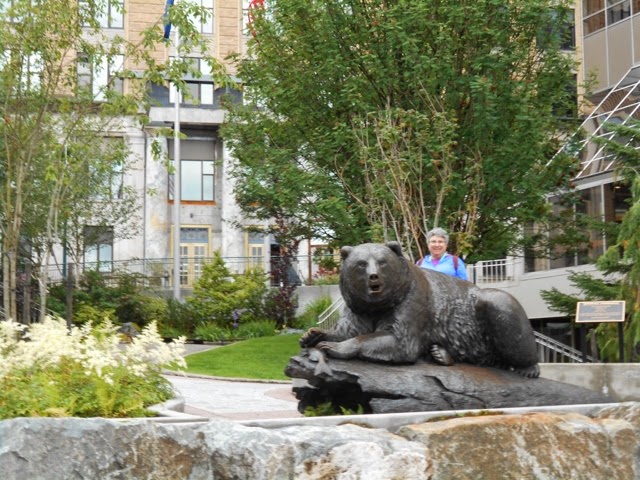Today’s event occurred on a beautiful early fall day. The
temperature (55-60°) was perfect for walking.
We started out at the Sourdough Mining Company, as we have
done for past YRE’s and regular events on the Campbell Creek Trail. However, instead of
turning left onto the trail, we turned right onto a new segment of the trail
and followed the Campbell Creek Greenbelt to the east.
While walking through a pleasant wooded section of the
trail, we noticed how high Campbell Creek was, due to recent rains. Then we
began to notice that the pavement was covered with hundreds of tiny slugs. It
was hard not to step on them because there were so many of them. Yuck! At least
they were tiny – not like the HUGE ones we saw on our Columbia River Gorge walks.
We crossed Campbell Creek using a nice wood pedestrian
bridge and continued following the trail under four overpasses of the Seward
Highway. There were some screens next to each underpass to keep snow from the
snowplows from falling on the trail in the winter. They had nice designs of
people enjoying outdoor activities. Too bad some lowlife felt the need to slash
several of them.
 |
| Side view of Campbell Creek from the viewing platform |
Soon we came to a short side trail leading to a viewing
platform. We went down this trail to get a better view of Campbell Creek.
Unfortunately, the trees have grown quite a bit since the platform was built,
so it was hard to get a good direct view, but you could see the creek from the side.
Soon we came to Waldron Lake. Our kids used to play soccer
here (a long time ago) and it looks like the field next to the lake is still
used for soccer. We saw Canada geese, mallards, and other types of ducks in the
lake.
The trail ended at an older subdivision. After two short
blocks we came to Lake Otis Parkway, a very busy street. We had to go south for
three blocks to the pedestrian tunnel under Lake Otis. On the way we
encountered some other walkers who told us the tunnel was a mess. We decided to
cross at the crosswalk instead, using the pedestrian walk signal. After
crossing we had to go north for three blocks to get to Campbell Park. This is a
popular park with a recently renovated playground. The new play structures were
very colorful and looked like a lot of fun, but I forgot to take pictures. :(
 |
| Waldron Lake |
 |
| I forgot to take pictures, but I found this one on the web. Pun intended. |
After making a big loop around the playground, we headed
back to the start point, while the 10k walkers continued along the trail to the
animal shelter.
 |
| Under the Seward Highway |
Walk Route: B-
It’s always
great to have a new route. The trail was very enjoyable, but the segment from 47th to the
playground was noisy and uninteresting, as was the segment under the four sections of the Seward Highway.
Walk Instructions: B+
Extremely clear
and precise instructions, but no map, no distance indications in the directions. Also, directions are easier to follow when they are numbered.












































